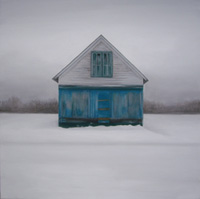The voice of the absent
“One can accomplish the thing quite quickly and turn toward the ruled outside space that defines our hesitations so majestically though negatively” John Ashbery, Three Poems
Walking side by side to what you are living can be the most vertiginous silence. Though in the case of painter Monica Dixon (New Jersey 1971), we would start by questioning ourselves about that small boat in which ordinary life is rocking, with its mufflers and findings, with its task in lull, always suspecting that we would like to find a way to understand what surrounds us, that could be adapted to our own nature.
We move through spaces in which we live not knowing what we keep in them. Time goes by and does not report what happens in it, but brings us shyaway from a light that speaks to us at dinner time or in the middle of the afternoon, when the light wants to talk more about its meaning: from inside out, between heaven and earth as between raw and cooked, suggesting a presence in figures that have stopped in the middle of their task, like Edward Hopper’s shipwrecked people without attributes, simply inhabitants of their time at shelter of the proximity of their distances. This is another arrangement. That found in the origin of our actions, where both painting and real life, become calligraphic memory that we cross with no purpose, or conscious that, in many cases, there is no path to follow and perhaps we were walking behind someone who moves foward and we let him pass, just as someone outlines a sketck. This is also a reality that disregards the artful and as Walker Evans showed in his photographs: no need of unnecessary strategies to advertise it, because reality is also revealed in the nature of the piece, in situations "without a story” and the certainty that they remain open in the insignificant, keeping a distance we can contemplate without being contaminated.
It is the anonymous object piled up anywhere around the house, or the room brougt out to light in its nude modesty, or perhaps it’s the façade where we stop ourselves and realize that it most likely resembles the face of the anonymous people that inhabit it; Representations of an enviroment that does not avoid its truss except for what it is in itself, form of common sense and sometimes, strangeness and censorship of the uneasy thought that stops in front of them.
Monica traces a parallel line to that feeling of movement, in which reality is at eye level, like a simple document that we find when passing through a hallway or climbing up the stairs, because we have become the external landscape which reference we have left back immersed in another. Circulation that determines the fleeting of what exists, the dwellings as compartments that describe the scenery of your life and the place where the intimate landscape has been a deserted spot longing for another architecture.
In this painting, the glass that frames us is a section of fine absence, not becoming speechless or with amnesia, but as a valuable and essential place, necessary to not evaporate ourselves, watered by our everyday experiences that reduces it furtherback to the matter, as can be admired in the humble homes of those absorbed spaces, isolated in the mystery of the surrounding landscape, the true face of silence. Where, as we approach, we should understand that they belong at that level whose melancholy has the capability of an untouchable portrait and it is they who are watching us, abandoned in the solitude of their quiet voice.
The finding of Monica’s painting lies in trying the impalpable through a certain feeling of uneasiness throug her eyes (though not sorrow), and thereby she tries out the voice of the quiet, with no doubt, an outdoor space that has thrived in the calm inside her to get to the personal and audible sound of her painting, as indeed Pessoa wrote in his Book of Disquiet: "At the end of this day is what was left of yesterday and tomorrow: the insatiable desire to always be the self and other. "
It is ultimately the harmony of a reality whose ends are also made with our personal depths, a whole reality, inside and out, at a time, and for a moment the most valuable chimera of telling story of our past.
Jose Luis Pastor
Text for " In & Out", the exhibition catalog in Mada Primavesi Art Gallery, November 2010
